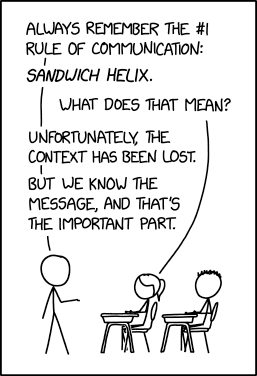Sandwich Helix

The number one rule of string manipulation is that you’ve got to specify your encodings.

The number one rule of string manipulation is that you’ve got to specify your encodings.
This comic details an important issue in communication: even if the content of your message goes through, there might be important context that is necessary to correctly interpret it.
Communication is a way to convey ideas, and Cueball is explaining a concept of communication he calls a "Sandwich Helix". However, when pressed on what that is, he says nobody knows — indicating that, over the years, communication has failed to retain the meaning of this supposedly very important concept. The humor is that if this truly was the #1 rule of communication, communication should have been able to retain its meaning. On the basis that the number #1 rule about communication would probably be the most important rule, it might even be construed to be the rule about properly communicating all context (by some apparent analogy), which would be irony — but only if anyone still understood it.
The comic also displays the difference between meaning and message. Cueball is parroting a message (possibly a cliche repeated by self-help authors and influencers), even though the meaning is lost.
The fictitious "Sandwich Helix" plays on another concept in communication, the "Compliment Sandwich" (a.k.a. "Shit Sandwich"), wherein a statement of criticism is sandwiched between two complimentary statements in order to make the negative statement easier to accept. The difference is that the Compliment Sandwich is a communication technique which is well known and whose meaning has not been lost (though it is currently disputed whether the technique is effective or whether it even might accomplish the inverse of its goals). A possible inspiration for the "helix" part is the Helical Model of Communication. The creator of the model, Frank Dance, emphasised the role of communication problems. He shows communication as a dynamic and non-linear process.
The title text contains several odd-looking characters that seem random (but are actually meaningful, to those familiar with them) where an apostrophe should be, as an example of a string that did NOT have its encoding handled properly. It is an example of Mojibake. Some special characters and symbols require a special encoding (such as UTF-8, Windows-1252, Shift-JIS, etc) in order to be stored and displayed properly, and are encoded using the equivalent of multiple characters. If the code to display the text doesn't understand what encoding was used and assumes a different/lesser level of encoding, you can get "garbage" similar to what is in the title text. In this case, the original character was
’, a "smart apostrophe" which, when encoded in UTF-8 and decoded in Windows-1252, becomes’. Similar garbage is seen in the title text of 1683: Digital Data. The apostrophe angled to the right, as opposed to the straight apostrophe normally typed on standard keyboards, is often intended to pair with a leftwards-angled one as marks at either end of some quoted text, `smartly´ applied by some word processing software by way of an autocorrection of what was typed - though not always when actually wanted, or correctly applied even when it might be.